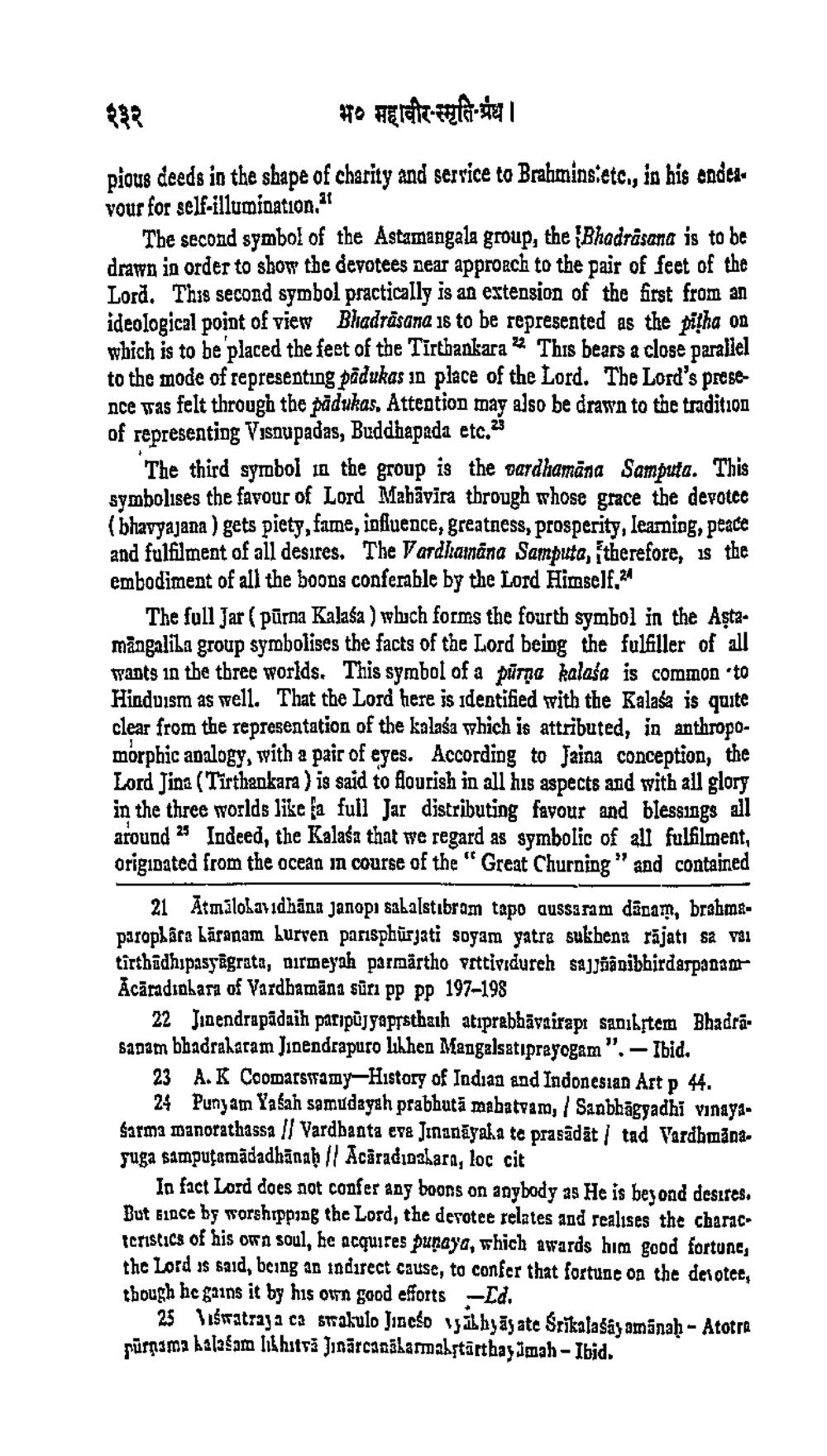________________
भ० महावीर-स्मृति ग्रंथ।
pious deeds in the shape of charity and service to Brahminsietc., in his endervour for self-illumination."
The second symbol of the Astamangala group, the Bhadrâsana is to be drawn in order to show the devotees near approach to the pair of feet of the Lord. This second symbol practically is an extension of the first from an ideological point of view Bhadrâsana is to be represented as the pitha on which is to be placed the feet of the Tirthankara 22 This bears a close parallel to the mode of representing padukas in place of the Lord. The Lord's presence vas felt through the pădukas, Attention may also be drawn to the tradition of representing Visnupadas, Buddhapada etc.23
'The third symbol in the group is the dardhamana Samputa. This symbolises the favour of Lord Mahavira through whose grace the defotec (bhavyajana ) gets piety, fame, influence, greatness, prosperity, learning, peace and fulfilment of all desires. The Vardhamana Samputa, (therefore, is the embodiment of all the boons conferable by the Lord Himself,34
The full Jar (pūrna Kalaša ) which forms the fourth symbol in the Aştamängalila group symbolises the facts of the Lord being the fulfiller of all Tants in the three worlds. This symbol of a pūmaz kalasa is common to Hinduism as well. That the Lord here is identified with the Kalasa is quite clear from the representation of the kalaśa which is attributed, in anthropomorphic analogy, with a pair of eyes. According to Jaina conception, the Lord Jina (Tirthankara) is said to flourish in all his aspects and with all glory in the three worlds like fa full Jar distributing favour and blessings all around 2 Indeed, the Kalaša that we regard as symbolic of all fulfilment, originated from the ocean in course of the "Great Churning" and contained
21 Atmālolavidhana Janapi sabalstıbram tapo aussamm dānam, brahmaparopláca Läranam burven parisphūrjati sogam yatra sukhena rājati sa vai tirthadhipasyêgrata, dirmeyah parmärtho yettividurch sajjüanibhirdarpanair Ācāradınları of Vardhamāna sūrı PP PP 197–198
22 Jinendrapādaih paripujyapfsthach atıprabhāvairapi sanılítem Bhadrasapam bhadraharam Jinendrapuro likhen Mangalsatıprayogam". - Ibid.
23 A. K Coomarsiramy-History of Indian and Indonesian Art p 44.
24 Punyam Yaśah samudayah prabhutā mabatyam, / Sanbhagyadhi vinayafarma manorathassa // Vardbanta eya Jinanāyaka to prasādāt, tad Vardhmāna. Fuga samputamādadhānab // Acaradidalara, loc cit
In fact Lord daes not confer any boons on anybody as He is beyond desires. But since he worshipping the Lord, the devotee relates and realises the characteristics of his own soul, he acquires punaya, which awards him good fortune, the Lord is said, being an indirect cause, to confer that fortune on the devotee, though he gains it by his otin good efforts -Ed.
25 liśmatraja ca stakulo lineếo abbyājate Srikalašây amanah - Atotra nurnama halašam likhitvi Jinārcanälarmalstarthayimah - Ibid.




